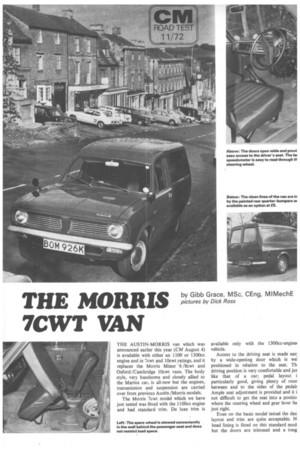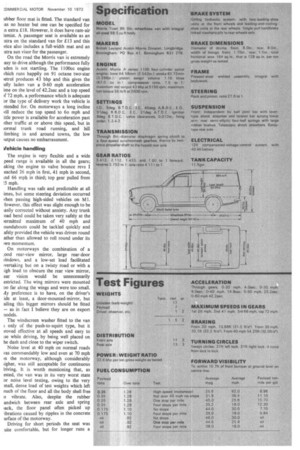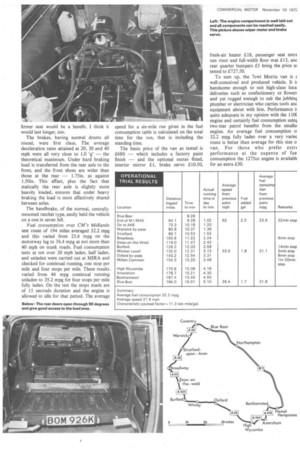THE MORRIS 7CWT VAN
Page 46

Page 47

Page 48

If you've noticed an error in this article please click here to report it so we can fix it.
by Gibb Grace, MSc, CEng, MIMechE pictures by Dick Ross THE AUSTIN-MORRIS van which was announced earlier this year (CM August 4) is available with either an 1100 or 1300cc engine and in 7cwt and lOcwt ratings, and it replaces the Morris Minor -6 /8cwt and Oxford/Cambridge lOcwt vans. The body style, very handsome and closely allied to the Marina car, is all-new but the engines, transmission and suspension are carried over from previous Austin /Morris models.
The Morris 7cwt model which we have just tested was fitted with the 1100cc engine and had standard trim. De luxe trim is available only with the 1300cc-engine4 vehicle.
Access to the driving seat is made eas; by a wide-opening door which is wel positioned in relation to the seat. Th driving position is very comfortable and jut like that of a car; pedal layout i particularly good, giving plenty of roon between and to the sides of the pedak Ample seat adjustment is provided and it i not difficult to get the seat into a positio: where the steering wheel and gear lever fet just right.
Even on the basic model tested the das. layout and trim are quite acceptable. N head lining is fitted on thisstandard mod but the doors are trimmed and a toug ubber floor mat is fitted. The standard van as no heater but one can be specified for .n extra £18. However, it does have ram-air lemist. A passenger seat is available as an :xtra on the standard van for 13 and this )rice also includes a full-width mat and an :xtra sun visor for the passenger.
On the road the Morris van is extremely :asy to drive although the performance fully aden is not startling. The 1100cc engine vhich runs happily on 91 octane two-star ietrol produces 43 bhp and this gives the ully laden van a 0-60 mph acceleration ime on the level of 42.2sec and a top speed If 72 mph, a performance which is adequate Or the type of delivery work the vehicle is ntended for. On motorways a long incline viii reduce the top speed to 6o mph and ittle power is available for acceleration past )ther traffic at or above this speed, but in iormal trunk road running, and hill limbing in and around towns, the low )utput causes no embarrassment.
liehicie handling The engine is very flexible and a wide peed range is available in all the gears; aking the engine to valve bounce revs I eached 26 mph in first, 41 mph in second, ind 66 mph in third; top gear pulled from 15 mph.
Handling was safe and predictable at all imes, but some steering deviation occurred vhen passing high-sided vehicles on Ml. lowever, this effect was slight enough to be :asily corrected without anxiety. Any trunk oad bend could be taken very safely at the iermitted maximum of 40 mph and oundabouts could be tackled quickly and afely provided the vehicle was driven round ather than allowed to roll round under its Iwn momentum.
On motorways the combination of a ;ood rear-view mirror, large rear-door vindows, and a low-set load facilitated ivertaking but on a twisty road or with a ugh load to obscure the rear view mirror, ear vision would be unnecessarily estricted. The wing mirrors were mounted oo far along the wings and were too small. Ay preference is to have, on the driver's ide at least, a door-mounted-mirror, but ailing this bigger mirrors should be fitted — as in fact I believe they are on export nodels.
The windscreen washer fitted to the van s only of the push-to-squirt type, but it )roved effective at all speeds and easy to ise while driving, by being well placed on he dash and close to the wiper switch.
Noise level at 40 mph on normal roads vas commendably low and even at 70 mph m the motorway, although considerably iigher, was still acceptable for continuous lriving. It is worth mentioning that, as ested, the van was in its very worst state or noise level testing, owing to the very mall, dense load of test weights which left nuch of the floor and all the body shell free o vibrate. Also, despite the rubber andwich between rear axle and spring oack, the floor panel often picked up ibrations caused by ripples in the concrete urface of the motorway.
Driving for short periods the seat was uite comfortable, but for longer runs a
firmer seat would be a benefit. I think it would last longer, too.
The brakes, having normal drums all round, were first class. The average deceleration rates attained at 20, 30 and 40 mph were all very close to 1.0 'g' the theoretical maximum. Under hard braking load is transferred from the rear axle to the front, and the front shoes are wider than those at the rear 1.75in. as against 1.50in. This effect, plus the fact that statically the rear axle is slightly more heavily loaded, ensures that under heavy braking the load is most effectively shared between axles.
The handbrake, of the normal, centrally mounted ratchet type, easily held the vehicle on a one in seven hill.
Fuel consumption over CM's Midlands test route of 194 miles averaged 32.2 mpg and this varied from 25.6 mpg on the motorway leg to 36.4 mpg at not more than 40 mph on trunk roads. Fuel consumption tests at not over 30 mph laden, half laden, and unladen were carried out at MIRA and checked for continual running, one stop per mile and four stops per mile. These results. varied from 46 mpg continual running unladen to 35.2 mpg for four stops per mile fully laden. On the test the stops made are of 15 seconds duration and the engine is allowed to idle for that period. The average speed for a six-mile run given in the fuel consumption table is calculated on the total time for the run, that is including the standing time.
The basic price of the van as tested is £680 which includes a factory paint finish and the optional extras fitted, interior mirror £1, brake servo £10.50, fresh-air heater £18, passenger seat extra sun visor and full-width floor mat £13, anc rear quarter bumpers £5 bring the price at tested to £727.50.
To sum up, the 7cwt Morris van is a well-conceived and produced vehicle. It it handsome enough to suit high-class loca deliveries such as confectionery or flower! and yet rugged enough to suit the jobbini plumber or electrician who carries tools anc equipment about with him. Performance it quite adequate in my opinion with the 110( engine and certainly fuel consumption usini two-star petrol benefits from the smallel engine. An average fuel consumption oi 32.2 mpg fully laden over a very variec route is better than average for this size o van. For those who prefer extn performance at the expense of fue consumption the 1275cc engine is availabb for an extra £30.




































































































































